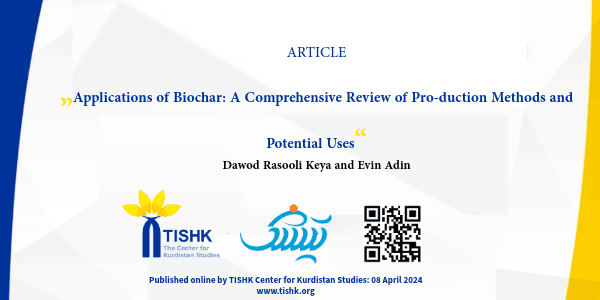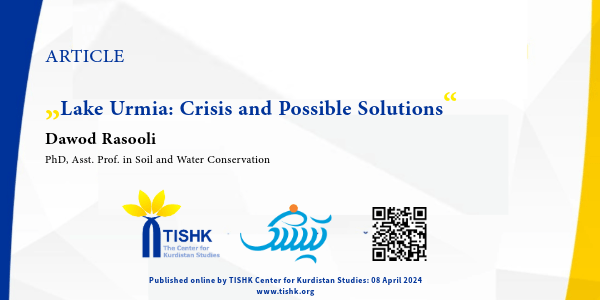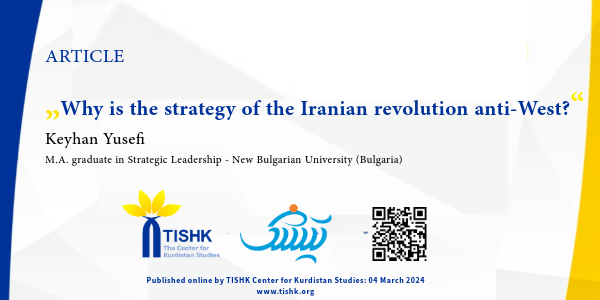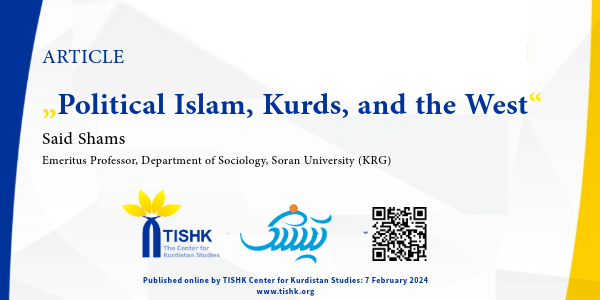ARTICLE
Lake Urmia Crisis and Possible Solutions
Published online by TISHK Center for Kurdistan Studies: 8 April 2024
Rasooli Keya, Dawod 2024. “Lake Urmia Crisis and Possible Solutions.” TISHK Center for Kurdistan Studies. Articles in Advance . https://doi.org/10.17605/OSF.IO/KM5B8
Abstract
Lake Urmia, located in northern part of Iranian Kurdistan, has recently experienced a serious environmental catastrophe because of various of factors, including human activity, climate change, and mismanagement water resource. The decline of Lake Urmia has caused several ecological, economic and social crises in the region. To put it another way, the issue at Lake Urmia, the biggest lake in the Middle East, is a sign of the lake’s declining ecological and environmental capabilities.
Addressing this crisis requires concerted efforts to change water resource management policies, prevent pollution, sustainable development and mitigate the impacts of climate change. International cooperation and support for the implementation of effective treatment to restore the lake’s ecological health is also essential for its return to normalcy. By implementing a combination of solutions in a coordinated and integrated manner, Lake Urmia may be preserved, and sustainability guaranteed for future generations. However, it will call for concerted efforts, cooperation and long-term commitment from the government, stakeholders, and the international community

Lake Urmia Crisis and Possible Solutions
Introduction
Lake Urmia, located in the northern of Iranian Kurdistan, has faced a significant environmental crisis in recent years due to numerous factors including climate change, human activities and mismanagement of water resources. The decline of Lake Urmia has caused several ecological, economic and social crises in the surrounding areas. In other words, the crisis of Lake Urmia indicates the decline of the environmental and ecological capacity of the lake, the largest lake in the Middle East.
© 2024 The Author(s), Published by TISHK Zentrum für Studien über Kurdistan. This article is licensed and distributed under CC BY-NC-ND 4.0. To view a copy of this license, visit http://creativecommons.org/licenses/by-nc-nd/4.0/ . To cite this article: Rasooli Keya, Dawod 2024. “Lake Urmia Crisis and Possible Solutions.”. TISHK Center for Kurdistan Studies. https://doi.org/10.17605/OSF.IO/PV4CH .
Addressing this crisis requires concerted efforts to change water resource management policies, prevent pollution, sustainable development and mitigate the impacts of climate change. International cooperation and support for the implementation of effective treatment to restore the lake’s ecological health is also essential for its return to normalcy.
By implementing a combination of solutions in a coordinated and integrated manner, Lake Urmia can be saved and sustainability ensured for future generations. But it will require concerted efforts, cooperation and long-term commitment by the government, stakeholders and the international community. Implementing a practical plan for the restoration of Lake Urmia requires a comprehensive approach that pays attention to the factors affecting its drying up. By following the Lake Urmia restoration plan, stakeholders can work together to reverse the decline in its water level and ensure the long-term sustainability of this important ecosystem.
Causes of drying up of Lake Urmia
Several natural and administrative factors have caused the crisis of Lake Urmia, which covers an area of 8% of its actual area. Here are the reasons:
Climate change and prolonged drought
One of the main causes of the Lake Urmia crisis is the prolonged drought in the region. Decreased rainfall and rising temperatures have caused a significant reduction in the flow of water into the rivers and streams that flow into the lake. The results of related studies showed that most stations in Lake Urmia Basin had a significant decreasing trend in last decades. Climate change has exacerbated the effects of drought in the region, leading to rising temperatures and changes in rainfall patterns. This climate change has accelerated the drying up of Lake Urmia and intensified the environmental challenges it faces.
Saltwater Intrusion and Water pollution
The decrease in freshwater inflow has caused the concentration of salts and minerals in the lake, which has increased the salinity level. This high salinity has hurt the lake’s life, including the extinction of some species that have adapted to lower salinity levels. Industrial and agricultural waste, including untreated wastewater and agricultural sewage containing pesticides and chemicals, has further deteriorated the water quality of Lake Urmia. Water pollution is exacerbating environmental pressure on the lake’s ecosystem, affecting aquatic life and biodiversity.
Mismanagement of water resources
Mismanagement of water resources, including excessive construction of dams and diversion of water for agricultural and industrial purposes, has significantly reduced the amount of water reaching Lake Urmia. Subsequently, the natural balance of the lake’s ecosystem has been disrupted causing its size to shrink.

Figure 1. The location of in operation, under construction and under study dams in Lake Urmia Basin, which is more than 91 dams. Source: daminfo.wrm.ir
Human activities
The impact of wrong policies on proper water resource management is also reflected in human activities such as excessive groundwater extraction for agriculture and urbanization in the areas around Lake Urmia. They also contributed to the decline in the water level of Lake Urmia. These activities have altered the hydrology of the region and reduced the amount of water available to fill the lake.

Figure 2. Change in the area of Lake Urmia between 2001 and 2023. Source: NASA; Shrinking Lake Urmia
Consequences of the Lake Urmia Crisis
The crisis in front of Lake Urmia has had profound consequences for both the environment and the residents of the surrounding areas. Here are some of the main findings and implications:
Environmental degradation
Decreasing water levels and rising salinity levels have caused the disappearance and drying up of ponds and several important settlements around Lake Urmia Water shortages have destroyed the lake’s ecosystem, resulting in the decline or extinction of many species of plants and animals, including migratory birds. However, the following negative consequences are significant: soil erosion and desertification in the region due to drying of the lake bed, loss of fertile land and salinization due to dust and rainfall and eventually decline in biodiversity.
Economic impact
The collapse of the Lake Urmia ecosystem has had a severe economic impact on local activities such as agriculture and tourism. In the future, the capacity of agricultural products may decline dramatically due to water shortages and soil acidification, or crops may be damaged and lost, and farmers’ incomes may decline the tourism sector, which once flourished around Lake Urmia, has suffered due to the deteriorating environmental conditions and unfavorable conditions for visitors.
Health Concerns
Increased levels of dust and salt particles at the bottom of the lake contribute to air pollution, which causes respiratory problems and health problems for citizens and residents of the area Increased salinity levels in groundwater and surface water sources have threatened the quality of drinking water, posing a threat to public health and exacerbating water-borne diseases. Another concern is the effect of salt on human and animal skin. Although this has not been studied, it certainly has such an effect on the human body in general and on the human skin.

Figure 3. Changes in the water composition of Lake Urmia and thickening of the salinity are observed. Source: ©Ali/Adobe Stock
Social migration and displacement
Environmental degradation and economic difficulties after the crisis in Lake Urmia will force many residents to migrate from the region in search of better livelihood opportunities elsewhere. Displacement and resettlement of communities will lead to deterioration of social conditions, loss of cultural heritage and difficulties in preserving traditional ways of life.
Conflicts and tensions
Competition for water resources has led to conflict and tension between different groups of stakeholders, including farmers, herders, industrialists and urban residents. Disputes over water allocation and management have complicated relations between communities and neighboring areas, as well as between upstream and downstream users of the lake basin.
Psychological effects
The loss of a once beautiful and ecologically rich natural resource has had a psychological impact on the population. Citizens are facing feelings of sadness, anxiety and hopelessness about the future of the environment and their way of life.
Projects submitted for the revival of Lake Urmia
In recent years, several projects have been proposed to supply water to Lake Urmia, some of which have not been approved for scientific or economic reasons. Here is a brief description of them:

Figure 4. Four projects submitted for water transfer to Lake Urmia. Sources: www.arannews.com; www.tasnimnews.com
Transferring water from the Caspian Sea
Based on a memorandum of understanding between the Lake Urmia Revitalization Agency and the Norwegian consulting company (NIVA), the opportunities and results of transferring water from the Caspian Sea to Lake Urmia began to be studied. The results of this research; indicated that mixing the water of the two lakes is not scientifically appropriate, especially in terms of chemical composition and salt types of southern parts of Lake Urmia. Also, the project’s economy required a huge budget that the Iranian state seemed to evade providing.
Transferring water from the Aras River
The objectives of the project are to transfer excess water from the Aras Dam to Lake Urmia to protect and restore the environment of Lake Urmia and provide drinking water to the towns and villages along the transmission line. It is worth mentioning that this project is not currently being implemented due to high cost and lack of budget. The geometric aspects of the project are as follows: Annual water transport capacity: 146 million cubic meters, maximum capacity of design and collection: 6.2 cubic meters per second, length of transmission line: 140 kilometers. Tunnel length: 14800 meters, pumping stations: 6, and dynamic pumping height: 660 meters.
Transferring water from the Lake Van
According to Iranian officials, the idea of the project was proposed by Turkish officials due to the rising level of Lake Van in recent years. Therefore, as a measure, they are considering transferring the excess water of this lake to Lake Urmia. However, it has been proposed that water should be transferred only to the northern part of Lake Urmia and the southern part of the lake should be supplied with river water. For this purpose, the lake should be divided into two separate parts by closing the bridge inside Lake Urmia (Shahid Kalantri). The consequences of the Lake division are very remarkable and require scientific and ecological analysis.
Transferring water from the Kani Sew Dam
This project, which is located on the Badinawe River, has been the most worked on so far. Its objectives include: transferring excess water from agricultural, drinking and industrial needs of the Badinawe watershed to Lake Urmia, controlling and regulating water and treating some of the declining water levels in Lake Urmia. Some of the engineering features of the project are as follows: Construction of a water transportation tunnel with a length of 17.2 kilometers and a capacity of 646 million cubic meters per year.

Figure 5. A view of the water transfer channel of the Kani Siu project. 70 km transmission line with an annual capacity of 300 million water from the Badinawe Dam to the Gadar River. Source: www.president.ir
Possible solutions to save Lake Urmia
Resolving the Lake Urmia crisis requires joint efforts to improve water management systems, reduce water pollution, sustainable development and mitigate the impacts of climate change. International cooperation and support are also essential to implement effective solutions to restore the ecological health of Lake Urmia and ensure the welfare of communities dependent on its resources. Efforts to address the consequences of the Lake Urmia crisis require joint work between government authorities, civil society organizations and international partners to implement a sustainable solution that revitalizes the lake’s ecosystem, supports those affected, and improves resilience to future environmental challenges.
Water Conservation, Climate resilience and adaptation
Implementation of efficient water management models and systems is very important for the restoration of Lake Urmia. This includes reducing water use in agriculture, industry and urban areas, as well as improving irrigation techniques to reduce water wastage. Certainly, water-based crops should be removed from the planting schedule and irrigation systems should be completely reformed. For example; surface irrigation should not be allowed because the water wastage rate is above 70%.
Given the impacts of climate change on water resources, there is a need for climate change mitigation strategies. From implementing water-efficient agricultural practices to developing infrastructure to withstand extreme weather events, the importance of adapting to changing climate conditions is emphasized.
Increase Inflow
Increasing the inflow of water from rivers to Lake Urmia can help replenish its water level. This can be done in the natural hydrological network through various methods such as the construction of dams, reservoirs, and diversion projects provided that the water is transferred directly to the lake through natural channels. On the other hand, expanding the forest area and protecting the soil in the surrounding areas, can help to replenish the volume of natural water.
Water Recycling
Using water treatment technology to remove salt from groundwater or surface water can provide additional sources of fresh water around the lake. In addition, the implementation of water reuse projects, especially in agriculture, industry, and households, can reduce the demand for freshwater, thus reducing the pressure on the lake.
Wetland Restoration
Revitalization and restoration of the wetlands around Lake Urmia are very important to maintain ecological balance and biodiversity. This includes restoring natural refuges, planting native plants, creating artificial ponds to improve water quality, preventing soil removal, and providing shelter for wildlife, implementing a comprehensive environmental plan to revive nature’s ability to accommodate species and develop its opportunities to live. This will restore the natural balance to the environment around Lake Urmia.
Public awareness and Community Engagement
It is important to raise awareness among the community, stakeholders and the general public about the importance of protecting Lake Urmia and adopting sustainable water management practices. Involving local communities in conservation efforts, empowering them to participate in decision-making processes, and providing incentives for conservation initiatives can increase the sense of ownership and responsibility toward protecting the lake. Recognizing that water resource management is a collective responsibility, stakeholder participation should be explored. All sections of society, businesses and government agencies must cooperate to ensure the success of water management initiatives. Educational programs and awareness campaigns are emphasized as key components of community participation.
Scientific Research and Monitoring
Scientific research and monitoring programs to assess the ecological health of Lake Urmia, understand the underlying causes of decline and assess the effectiveness of conservation measures are essential for informed decision-making and appropriate management of water resources. A detailed assessment of the current condition of Lake Urmia, including water level, salinity, ecological health and socio-economic impacts should be conducted. Conduct scientific research to understand the underlying causes of lake decline, including factors such as climate change, poor water resource management, agricultural practices and industrial pollution.
Implementation of continuous monitoring programs to collect information on water quality, biodiversity, ecosystem health, and socio-economic indicators is critical. Scientific evidence and accurate feedback are needed to evaluate the strategies used in the management of the Lake Urmia restoration project based on the challenges and opportunities.
Practical plan for the restoration of Lake Urmia
Implementation of a practical plan for Lake Urmia restoration requires a comprehensive approach that addresses the contributing causes of Lake Urmia’s drying up.
Sustainable Water Management
The principle of sustainable water management emphasizes the importance of equity, efficiency and environmental protection. The concept of Integrated Water Resources Management (IWRM) as a framework for water management and use is very important because it takes into account social, economic and environmental factors at the same time.
Regarding technological innovations in water management, a significant part is devoted to the research of advanced technologies that are a revolution in water resource management They do. Smart irrigation networks, satellite-based monitoring, and water treatment innovations are discussed as tools to increase efficiency, reduce pollution, and improve the quality of water resources.
Develop and implement water management plans that focus on reducing water use in agriculture, industry and urban areas through improved irrigation practices, water reuse and water treatment. Several of measures should be considered such as implementing regulations to prevent illegal extraction of groundwater and promote sustainable water use practices, investing in infrastructure projects to increase freshwater inflow into the lake, identifying suitable areas for rehabilitation of ponds around Lake Urmia Relying on their ecological importance and potential, rehabilitating natural refuges and restoring natural hydrological processes, establishing protected areas to protect and promote biodiversity.

Figure 6. Integrated Water Resources Management (IWRM) Structure. Source: www.wateryouthnetwork.org
Politics, Governance and International Cooperation
Water impact management requires a strong legal and regulatory framework. This subject discusses the importance of clear water rights, licensing processes and the establishment of those responsible for overseeing water governance. Research on successful water management policies around the world provides valuable insights into designing effective governance structures. Given the impact of this crisis that crosses political boundaries, international cooperation between resource partners, such as Iran, Azerbaijan, Armenia and Turkey, to implement a comprehensive strategy and sign agreements to address common challenges and ensure appropriate solutions, it’s very important.
Funding and Partnerships
Mobilize financial resources from government budgets, international donors and private sector investments to support lake restoration projects and ongoing management efforts. Partner with research institutions, NGOs and local communities to use their expertise, resources and networks to effectively implement rehabilitation plans. By following this action plan for the restoration of Lake Urmia, stakeholders can work together to reverse the drying up and ensure the long-term sustainability of this important ecosystem. In short, by implementing a combination of these solutions in a coordinated and integrated manner, Lake Urmia can be saved and sustainability ensured for future generations. But it will require joint efforts, cooperation and long-term commitment from the government, stakeholders and the international community.
References:
Abadi, B. (2019). “How Agriculture Contributes to Reviving the Endangered Ecosystem of Lake Urmia? The Case of Agricultural Systems in Northwestern Iran.” Journal Of Environmental Management, 236, 54-67. https://doi.org/10.1016/J.JENVMAN.2019.01.111 .
Abbaspour, M., and Nazaridoust, A. (2007). “Determination Of Environmental Water Requirements of Lake Urmia, Iran: An Ecological Approach.” International Journal of Environmental Studies, 64, 161-169. https://doi.org/10.1080/00207230701238416 .
Alipour, H., and Olya, H. (2015). “Sustainable Planning Model Toward Reviving Lake Urmia.” International Journal of Water Resources Development, 31, 519-539.
Alizadeh-Choobari, O., Ahmadi-Givi, F., Mirzaei, N., and Owlad, E. (2016). ”Climate Change and Anthropogenic Impacts on The Rapid Shrinkage of Lake Urmia.” International Journal of Climatology, 36, 4276-4286. https://doi.org/10.1002/JOC.4630 .
Azimi, F., Javadian, M., Chehrenegar, B., and M. Tajrishi. (2017). “Effect of change in Lake Urmia water level in reduction of areas with dust producing potentials.” Proceedings of 4th National Conference on Wind Erosions and Dust Storms, Tehran, Iran.
Biswas, A. K. (2008). Integrated water resources management: Is it working? Water Resources Development, 24(1), 5-22.
Danesh-Yazdi, M., and Ataie-Ashtiani, B. (2019). “Lake Urmia crisis and restoration plan: Planning without appropriate data and model is gambling.” Journal of Hydrology, 576, 639-651.
Falkenmark, M. (2007). Water management in the 21st century: what will be new? Philosophical Transactions of the Royal Society B: Biological Sciences, 362(1486), 2337-2346
Garrick, D., & Hall, J. W. (2014). Water Governance in the Face of Global Change: From Understanding to Transformation. Springer.
Ghashghaie, M., and Nozari, H. (2018). “Effect Of Dam Construction on Lake Urmia: Time Series Analysis of Water Level Via Arima.” Journal Of Agricultural Science and Technology, 20, 1541-1553. NA.
GWP (Global Water Partnership). (2000). Integrated Water Resources Management. TAC Background Papers No. 4.
Hamidi-Razi, H., Mazaheri, M., Carvajalino, F., M, and Vali, S., J. (2019). ”Investigating The Restoration of Lake Urmia Using A Numerical Modelling Approach.” Journal Of Great Lakes Research, 45, 87-97. https://doi.org/10.1016/J.JGLR.2018.10.002 .
Loucks, D. P., & van Beek, E. (Eds.). (2017). Water Resources Systems Planning and Management. Springer.
Mohebzadeh, H., and Fallah, M. (2019). “Quantitative Analysis of Water Balance Components in Lake Urmia, Iran Using Remote Sensing Technology.” Remote Sensing Applications: Society And Environment, 13, 389-400. https://doi.org/10.1016/J.RSASE.2018.12.009 .
Website references:
http://www.iikss.com
https://ana.ir
Dr. Dawod Rasooli is Assistant Professor of Soil and Water Conservation in the Department of Crop Production. He received his Ph.D. in 2020 from Salahaddin University – Erbil (SUE). In 2009, he joined the Polytechnic University of Erbil, where he worked as a lecturer in the Department of Crop Production and as a researcher. His research is in the field of soil conservation, estimation of soil erosion, rainfall characteristics, evapotranspiration (ETo) and crop water requirements. His main research interests include Erosivity Index and Rainfall Energy Measurement (REM). Dawod teaches several courses on Fundamentals of Plane Surveying, Fundamentals of Soil Science and Soil Fertility, Irrigation Systems, Computer Essentials, Watershed Management and Landscape Engineering. Dawod has also conducted seminars and symposia on Soil and Water Sciences for academics and professionals in collaboration with EPU. He has published 4 books on Soil and Water Science in Kurdish and English.






